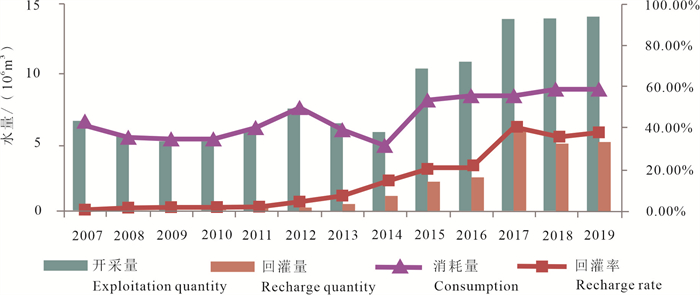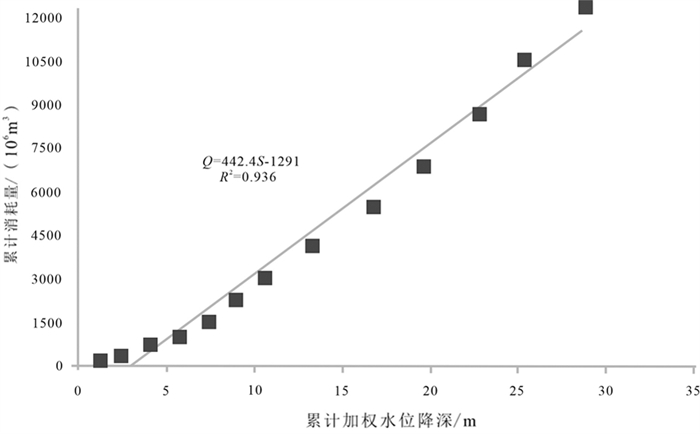Calculation method and suitability zoning of recoverable geothermal fluid in Guantao Formation of Tianjin City
-
摘要:
研究目的 “十四五”是碳达峰的关键期、窗口期,要求着力合理推动能源清洁利用和低碳转型,天津市低碳清洁能源——地热资源丰富,对调整能源结构、节能减排、改善环境有着重要的意义。天津市开展了《天津市矿产资源规划(2021—2025年)》的编制工作。其中为了夯实规划编制基础、摸清地热资源禀赋,设置评价专题对天津市地热资源潜力进行深入研究。
研究方法 专题通过采用热储法、统计分析法和数值模拟法对天津市馆陶组地热资源潜力进行评价和对比。
研究结果 热储法在不考虑回灌及其他约束条件的情况下,馆陶组地热流体可开采量为0.94×108 m3/a;统计分析法在考虑回灌、水位降幅及水位降深的情况下,馆陶组地热流体可开采量为0.28×108 m3/a;数值模拟法在考虑回灌、温度降幅及水位降深的情况下,馆陶组地热流体可开采量为0.296×108 m3/a。
结论 通过对比研究,认为采用统计分析法和数值模拟法计算结果可信度较高,并且利用了基于GIS的层次分析法,将GIS技术和层次分析法相结合,对馆陶组地热资源开发利用潜力进行综合性评价及适宜性分区。
Abstract:This paper is the result of geothermal resources survey engineering.
Objective The "14th Five-Year Plan" is a critical period and a window period for carbon peaking. It requires efforts to promote clean energy utilization and low-carbon transformation rationally. Low-carbon and clean geothermal resources in Tianjin are abundant. It is significant to adjust the energy structure and conservation and improve the environment. Tianjin has carried out the compilation of the "Tianjin Mineral Resources Planning (2021-2025)". Among them, to consolidate the foundation of planning and finding geothermal reserves, an evaluation topic is set up to conduct in-depth research on the potential of geothermal resources in Tianjin.
Methods The special topic evaluates and compares the geothermal resource potential of the Tianjin Guantao Formation by using the thermal storage method, statistical analysis method, and numerical simulation method.
Results It is concluded from the research that the recoverable amount of geothermal fluid in the Guantao Formation is 0.94×108m3/a without considering recharge and other constraints; with statistical analysis method in the case of considering recharge, water level depth, and water level drop, the recoverable amount of geothermal fluid in Guantao Formation is 0.28×108m3/a; numerical simulation method in the case of considering recharge, temperature drop and water level drop, the recoverable amount of geothermal fluid in Guantao Formation is 0.296×108m3/a.
Conclusions Through comparative research, it is believed that the statistical analysis method and numerical simulation method are used to calculate the reliability of the results. The GIS-based AHP is used, and the GIS technology and the AHP are combined to carry out comprehensive evaluation and suitability zoning of geothermal resource development and utilization potential in the Guantao Formation.
-

-
表 1 天津市馆陶组热储参数
Table 1. Thermal storage parameters of the Guantao Formation in the Tianjin
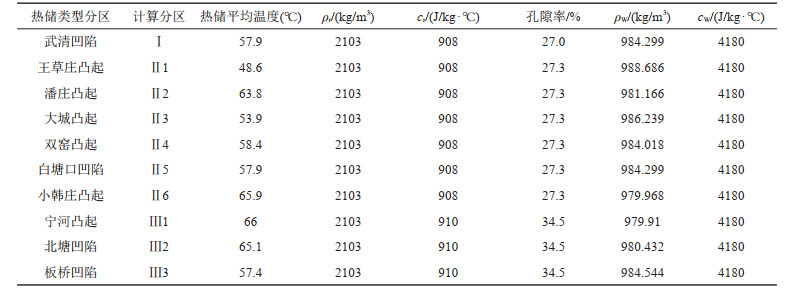
表 2 各构造单元地热资源量统计
Table 2. Statistics of geothermal resources of each structural unit
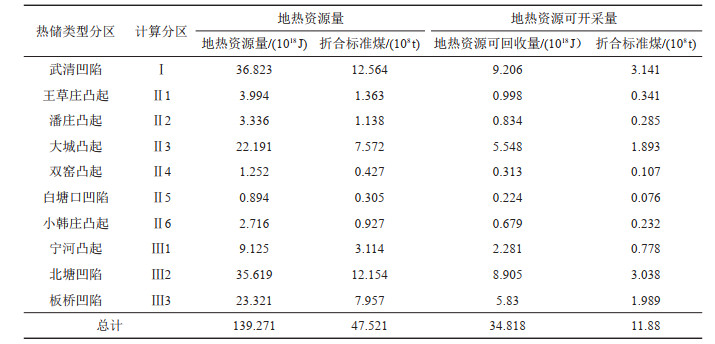
表 3 各构造单元地热流体储存量及可开采量统计
Table 3. Statistics of geothermal fluid storage capacity and recoverable capacity of each structural unit
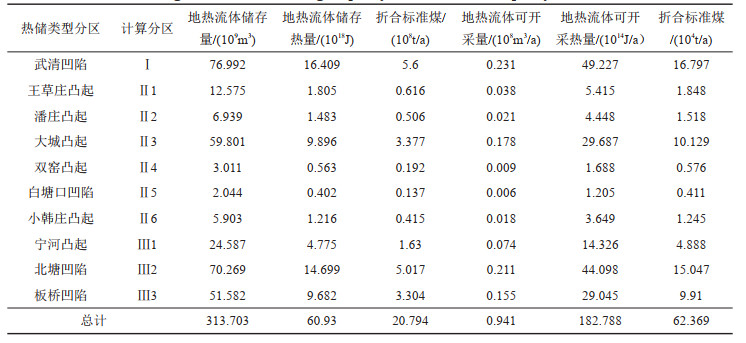
表 4 各区可消耗量统计
Table 4. Consumption statistics of each district

表 5 不同计算原则下的可开采量统计
Table 5. Statistics of the mineable volume under different calculation principles

表 6 不同计算原则下的可开采量统计
Table 6. Statistics of the mineable volume under different calculation principles

表 7 不同方法计算年可开采量对比(108 m3/a)
Table 7. Comparison of different methods to calculate the annual mining capacity (108m3/a)

表 8 评价因子权重分配
Table 8. Weight distribution of evaluation factor

表 9 评价得分及评定等级
Table 9. Evaluation score and grade

表 10 馆陶组热储层分区情况
Table 10. Thermal reservoir zoning in Guantao Formation

-
Chen Moxiang. 1988. Geothermal in North China[M]. Beijing: Science Press (in Chinese).
Chen Qinglong, Huang Rui, Pu Renhai, Wang Bin, Sun Long, Wang Yanxin. 2021. Study on classification and correlation of thermal reservoir strata and geothermal favorable area in Renxian area, Hebei Province[J]. Journal of Geology, 45(3): 316-326(in Chinese with English abstract). doi: 10.3969/j.issn.1674-3636.2021.03.014
Hong Zenglin, Zhang Yinlong, Zhou Yang. 2019. Research on the modes of occurrence and application of geothermal resources in the middle and deep layers of the piedmont area in southern Guanzhong Basin[J]. Geology in China, 46(5): 1224-1235(in Chinese with English abstract).
Hu Qiuyun, Gao Jun, Ma Feng, Zhao Zhihong, Liu Guihong, Wang Guiling, Zhang Wei, Zhu Xi, Zhang Baojian, Xing Yifei. 2020. Dynamic prediction of geothermal recoverable resources in the Rongcheng uplift area of the Xiong'an New Area[J]. Acta Geologica Sinica, 94(7): 2013-2025(in Chinese with English abstract). doi: 10.3969/j.issn.0001-5717.2020.07.010
Huang Jichao, Rong Fuqiang, Wang Tielin. 2022. Study on the distribution and development and utilization of geothermal resources in Jingkai District of Zhengzhou City[J]. Henan Water Resources and South-to-North, 51(1): 27-31 (in Chinese with English abstract).
Li Shengtao, Yue Dongdong, Feng Zhaolong, Song Jian, Liu Donglin, Song Zhibin, He Guolei, Long Hui, Hao Wenjie, Zhang Qiuxia. 2022. Sinoprobe and parameters study on deep karst geothermal reservoir in the Donglihu Area, Tianjin and its exploitable potential analysis[J]. Geology in China, 49(6): 1732-1746(in Chinese with English abstract).
Lin Li, Zhao Sumin, Ruan Chuanxia. 2007. The inhomogeneity characteristics of geothermal storing karst caves of Wumishan reservoir of Jixian System in the deep part of Tianjin[J]. Geoscience, 21(4): 600-604 (in Chinese with English abstract). doi: 10.3969/j.issn.1000-8527.2007.04.002
Lin Wenjing, Liu Zhiming, Wang Wanli, Wang Guiling. 2013. The assessment of geothermal resources potential of China[J]. Geology in China, 40(1): 312-320(in Chinese with English abstract). doi: 10.3969/j.issn.1000-3657.2013.01.021
Liu Jie, Song Meiyu, Tian Guanghui. 2012. Development Situation of the geothermal resources and suggestion on sustainable development utilization in Tianjin[J]. Geological Survey and Research, 35(1): 67-73(in Chinese with English abstract).
Liu Kai, Wang Shanshan, Sun Ying, Cui Wenjun, Zhu Deli. 2017. Characteristics and regionalization of geothermal resources in Beijing[J]. Geology in China, 40(1): 312-320(in Chinese with English abstract).
Ma Bing, Jia Lingxiao, Yu Yang, Wang Huan. 2021. The development and utilization of geothermal energy in the world[J]. Geology in China, 48(6): 1734-1747 (in Chinese with English abstract).
Mao Xiaoping, Wang Xinwei, Li Kewen, Guo Shaobin. 2018. Sources of heat and control factors in geothermal field[J]. Earth Science, 43(11): 4256-4266(in Chinese with English abstract).
Mei Bo, Zhang Yanfeng, Yang Yunzhan, Xing Hualu, Chang Linzhen, Liu Pufeng. 2021. Geochemical characteristics and origin of geothermal water of Guantao formation in Huanghua depression (Cangzhou region)[J]. Mineral Exploration, 12(6): 1366-1377(in Chinese with English abstract). doi: 10.3969/j.issn.1674-7801.2021.06.008
Ru Hongjiu, Liu Donglin, Hu Huichuan, Shen Jian. 2018. Evaluation and comprehensive study of geothermal resources in Tianjin[J]. Geological Survey of China, 5(2): 25-31(in Chinese with English abstract).
Tang Yongxiang, Cheng Wanqing, Zhao Sumin, Tian Guanghui, Li Yuanyuan, Zeng Meixiang, Li Hao. 2020. Evaluation of deep geothermal resources and delineation of favorable exploration areas in Binhai New Area, Tianjin[J]. Geological Survey of China, 7(4): 37-42(in Chinese with English abstract).
Tianjin Bureau of Geology. 1992. Tianjin Regional Geological Records[M]. Beijing: Geological Publishing House(in Chinese).
Wang Guiling, Zhang Wei, Lin Wenjing, Liu Feng, Zhu Xi, Liu Yanguang, Li Jun. 2017. Research on formation mode and development potential of geothermal resources in Beijing-Tianjin-Hebei region[J]. Geology in China, 44(6): 1074-1085 (in Chinese with English abstract).
Wang Guiling, Wang Wanli, Zhang Wei, Ma Feng, Liu Feng. 2020. The status quo and prospect of geothermal resources exploration and development in Beijing-Tianjin-Hebei region in China[J]. China Geology, 3(1): 173-181. doi: 10.31035/cg2020013
Wang K. 2008. Background, history and status of geothermal utilization in Tianjin[C]// Workshop for Decision Makers on Direct Heating Use of Geothermal Resources in Asia, 12-23.
Wang Xinwei, Guo Shiyan, Gao Nan'an, Liu Huiying, Wang Tinghao, Wei Guangren, Lei Haifei. 2023. Detection of carbonate geothermal reservoir in Niudong fault zone of Xiong'an New Area and its geothermal exploration significance[J]. Geological Bulletin of China, 42(1): 14-26731(in Chinese with English abstract).
Wang Xinwei, Wang Tinghao, Li Haiquan, Zhang Xuan, Luo Lu, Liu Huiying, Wang Simin, Xiang Caifu. 2022. Evolution of karst geothermal system and its geothermal resource potential in Taiyuan Basin[J]. Geology in China, 49(3): 716-731(in Chinese with English abstract).
Wu Aimin, Ma Feng, Wang, Guiling, Liu Jinxia, Hu Qiuyun, Miao Qingzhuang. 2018. A study of deep-seated karst geothermal reservoir exploration and huge capacity geothermal well parameters in Xiongan new area[J]. Acta Geoscientica Sinica, 39(5): 523-532(in Chinese with English abstract).
Xie Na, Yu Shengbo, Ding Hongwei, Zhang Mingquan. 2020. Occurrence features of geothermal resources and geothermal potential assessment in Gansu Province[J]. Geology in China, 47(6): 1804-1812(in Chinese with English abstract).
Yu Yan, Qin Lihong, Lin Wei, Kang Nan, Liu Jie, Meng Xiangbo. 2016. Practical and theoretical calculation comparative study on the geothermal resources development in Tianjin[J]. North China Geology, 39(3): 221-225(in Chinese with English abstract).
Zhang Baiming, Lin Li, Zhao Sumin. 2006. Analyses on mechanism or geothermal origin in Tianjin area[J]. Hydrogeology and Engineering Geology, 33(2): 104-107(in Chinese with English abstract). doi: 10.3969/j.issn.1000-3665.2006.02.025
Zhang Fenna, Jia Zhi, Li Hu, Gao Liang, Zong Zhenhai. 2016. Evolution of geothermal fluids in Guantao layer of Tanggu district in Tianjin[J]. North China Geology, 39(2): 149-152(in Chinese with English abstract).
Zhang Wei, Wang Guiling, Liu Feng, Xing Linxiao, Li Man. 2019. Characteristics of geothermal resources in sedimentary basins[J]. Geology in China, 46(2): 255-268(in Chinese with English abstract).
Zhang Zhongxiang, Han Jianjiang, Xu Jian, Geng Dongqing, Li Changsuo, Liu Guoai. 2005. The calculation of exploitable resources in the layered-geothermal reservoirs of sedimentary basin[J]. Hydrogeology & Engineering Geology, 32(1): 73-77(in Chinese with English abstract).
Zhao Zhen, Yu Piaoluo, Chen Huijuan, Luo Yinfei, Zhao Dongyang, Bian Jiang. 2015. Genetic analysis and resource evaluation of the Xining geothermal field in Qinghai Province[J]. Geology in China, 42(3): 803-810(in Chinese with English abstract).
陈墨香. 1988. 华北地热[M]. 北京: 科学出版社.
陈庆龙, 黄锐, 蒲仁海, 王彬, 孙龙, 王妍心. 2021. 河北任县地区热储地层划分对比及地热有利区[J]. 地质学刊, 45(3): 316-326. doi: 10.3969/j.issn.1674-3636.2021.03.014
洪增林, 张银龙, 周阳. 2019. 关中盆地南部山前中深层地热资源赋存特征及应用[J]. 中国地质, 46(5): 1224-1235. http://geochina.cgs.gov.cn/cn/article/doi/10.12029/gc20190522
胡秋韵, 高俊, 马峰, 赵志宏, 刘桂宏, 王贵玲, 张薇, 朱喜, 张保建, 邢一飞. 2020. 雄安新区容城凸起区地热可采资源量动态预测[J]. 地质学报, 94(7): 2013-2025. doi: 10.3969/j.issn.0001-5717.2020.07.010
黄继超, 荣富强, 王铁霖. 2022. 郑州市经开区地热资源分布及开发利用研究[J]. 河南水利与南水北调, 51(1): 27-31.
李胜涛, 岳冬冬, 冯昭龙, 宋健, 刘东林, 宋志彬, 和国磊, 龙慧, 郝文杰, 张秋霞. 2022. 天津东丽湖深部岩溶热储探测与储层参数研究及其开发利用潜力分析[J]. 中国地质, 49(6): 1732-1746. http://geochina.cgs.gov.cn/cn/article/doi/10.12029/gc20220603
林黎, 赵苏民, 阮传侠. 2007. 天津地区深部蓟县系雾迷山组热储岩溶非均一性特征研究[J]. 现代地质, 21(4): 600-604.
蔺文静, 刘志明, 王婉丽, 王贵玲. 2013. 中国地热资源及其潜力评估[J]. 中国地质, 40(1): 312-320. doi: 10.3969/j.issn.1000-3657.2013.01.021
刘杰, 宋美钰, 田光辉. 2012. 天津地热资源开发利用现状及可持续开发利用建议[J]. 地质调查与研究, 35(1): 67-73.
刘凯, 王珊珊, 孙颖, 崔文君, 朱德莉. 2017. 北京地区地热资源特征与区划研究[J]. 中国地质, 44(6): 1128-1139. http://geochina.cgs.gov.cn/cn/article/doi/10.12029/gc20170607
马冰, 贾凌霄, 于洋, 王欢. 2021. 世界地热能开发利用现状与展望[J]. 中国地质, 48(6): 1734-1747. http://geochina.cgs.gov.cn/cn/article/doi/10.12029/gc20210606
毛小平, 汪新伟, 李克文, 郭少斌. 2018. 地热田热量来源及形成主控因素[J]. 地球科学, 43(11): 4256-4266.
梅博, 张岩峰, 杨云展, 邢化庐, 常林祯, 刘普峰. 2021. 黄骅台陷(沧州段)馆陶组地热水地球化学特征及成因分析[J]. 矿产勘查, 12(6): 1366-1377.
茹洪久, 刘东林, 胡慧川, 沈健. 2018. 天津地热资源评价与综合研究[J]. 中国地质调查, 5(2): 25-31.
唐永香, 程万庆, 赵苏民, 田光辉, 李嫄嫄, 曾梅香, 李昊. 2020. 天津滨海新区深部地热资源评价及有利勘探区圈定[J]. 中国地质调查, 7(4): 37-42.
天津市地矿局. 1992. 天津市区域地质志[M]. 北京: 地质出版社.
王贵玲, 张薇, 蔺文静, 刘峰, 朱喜, 刘彦广, 李郡. 2017. 京津冀地区地热资源成藏模式与潜力研究[J]. 中国地质, 44(6): 1074-1085. http://geochina.cgs.gov.cn/cn/article/doi/10.12029/gc20170603
王贵玲, 蔺文静. 2020. 我国主要水热型地热系统形成机制与成因模式[J]. 地质学报, 94(7): 1923-1937. doi: 10.3969/j.issn.0001-5717.2020.07.002
汪新伟, 郭世炎, 高楠安, 刘慧盈, 王婷灏, 魏广仁, 雷海飞. 2023. 雄安新区牛东断裂带碳酸盐岩热储探测及其对地热勘探的启示[J]. 地质通报, 42(1): 14-26.
汪新伟, 王婷灏, 李海泉, 张瑄, 罗璐, 刘慧盈, 王嗣敏, 向才富. 2022. 太原盆地岩溶地热系统的形成演化及其地热资源潜力[J]. 中国地质, 49(3): 716-731. http://geochina.cgs.gov.cn/cn/article/doi/10.12029/gc20220304
吴爱民, 马峰, 王贵玲, 刘金侠, 胡秋韵, 苗青壮. 2018. 雄安新区深部岩溶热储探测与高产能地热井参数研究[J]. 地球学报, 39(5): 523-532.
谢娜, 喻生波, 丁宏伟, 张明泉. 2020. 甘肃省地热资源赋存特征及潜力评价[J]. 中国地质, 47(6): 1804-1812. http://geochina.cgs.gov.cn/cn/article/doi/10.12029/gc20200616
于彦, 秦莉红, 林溦, 康楠, 刘杰, 孟祥博. 2016. 天津地热资源开采情况实际与理论计算对比研究[J]. 地质调查与研究, 39(3): 221-225. doi: 10.3969/j.issn.1672-4135.2016.03.010
张百鸣, 林黎, 赵苏民. 2006. 天津地区地热形成机理分析[J]. 水文地质工程地质, 33(2): 104-107. doi: 10.3969/j.issn.1000-3665.2006.02.025
张芬娜, 贾志, 李虎, 高亮, 宗振海. 2016. 天津塘沽地区馆陶组地热流体演变特征研究[J]. 地质调查与研究, 39(2): 149-152. doi: 10.3969/j.issn.1672-4135.2016.02.012
张薇, 王贵玲, 刘峰, 邢林啸, 李曼. 2019. 中国沉积盆地型地热资源特征[J]. 中国地质, 46(2): 255-268. http://geochina.cgs.gov.cn/cn/article/doi/10.12029/gc20190204
张中祥, 韩建江, 徐健, 耿冬青, 李常锁, 刘国爱. 2005. 沉积盆地型层状热储可采资源量计算方法探索[J]. 水文地质工程地质, 32(1): 73-77. doi: 10.3969/j.issn.1000-3665.2005.01.018
赵振, 于漂罗, 陈惠娟, 罗银飞, 赵东阳, 边疆. 2015. 青海省西宁地热田成因分析及资源评价[J]. 中国地质, 42(3): 803-810. doi: 10.3969/j.issn.1000-3657.2015.03.029
-




 下载:
下载:


